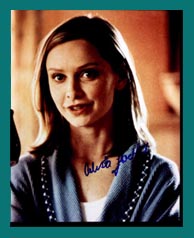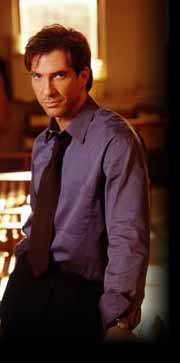
- Ysaiah Ross (formerly Stan Ross) is an academic barrister who has
- published a number of books on the legal profession and ethics. Most recent
- are 'The Joke's on ...Lawyers' (Federation Press, 1996) and 'Ethics in Law, 2nd ed' (Butterworths 1998)
- "
- The Practice
and Ally McBeal deal with such vastly different social problems and
cases that it is difficult to believe the same person created them.
- "
- "
- In my view although The Practice is American, it is a must for any Australian lawyer
interested in complex legal ethical issues.
- "
Legal Ethics on TV Through Australian Eyes
by Ysaiah Ross
The
new television season in Australia has just started with its usually large
number of serials on American lawyers. The new season includes Judging Amy,
Law and Order, The Practice and Ally McBeal. On day-time TV Judge Judy
reruns continue everyday during the week.
The
new series of The Practice
continues its wonderful approach to legal ethics issues.
David Kelley, who is married to Michelle Pfeiffer, created both The
Practice and Ally McBeal. Kelley also has been a producer and scriptwriter for ER,
LA Law and Picket
Fences. The Practice and Ally McBeal deal with such vastly different social problems and
cases that it is difficult to believe the same person created them.
The
hugely popular Ally McBeal’s
emphasis is one-dimensional – mainly sex and sexual problems – usually
arising out of Ally’s psychological problems and/or family law cases. The
first program of the new season followed this format. It looked at a case in
which an unattractive woman, who argued that her spouse never really loved
her and married her only for her money, sought an annulment. The other part
of the program dealt with Ally seeking psychological advice for her sexual
problems with her boyfriend who wants to live with her. Ally mistakenly
sought this advice from a practitioner who she thought was a therapist and
turns out to be a lawyer. The program at times touches on lawyers’ ethics
but only in passing and frequently to evoke humour.
By
contrast David Kelley’s The Practice
places lawyers’ ethics as the central element of the program. This does
not mean that there is not a human touch. The main character, Bobby Donnell,
has had an affair with the leading prosecutor, Helen Gamble. This affair
caused all kinds of ethical problems for both of them personally and
professionally. For example in one of the programs Bobby is making love with
Helen and the phone rings. Helen is informed about a raid on the house of a
drug dealer who happens to be one of Bobby’s clients. Bobby accidentally
gets this information and feels obliged to tell his client. As a result when
the raid takes place several police are killed. Helen feels she has breached
her professional obligations. She also feels that she cannot trust herself or Bobby. Thus she breaks off their relationship. Bobby then falls
in love with one of his partners, Lindsay Dole who lived with Helen. Again
this relationship leads to various conflict of interest situations.
Originally
Bobby’s firm handled primarily criminal defence work but in recent
programs there has been an increasing number of civil cases. The first
program dealt with two cases – one of them civil. This case involved
Lindsay and another partner Ellenor Frutt. They had taken on a toxic
poisoning civil action. Three children were exposed to toxins in a
playground and suffered serious illness and disability. In the States such
cases are almost always on a contingent basis. Small firms are willing to
front the large outlays required to bring such litigation because the
companies being sued have deep pockets or are covered by insurance.
 It
turns out that in the playground case that the usual defendants are no
longer in business and the only party to be sued is a federal governmental
agency responsible for enforcing protection of the environment.
In this respect The Practice fudged the law for entertainment purposes; it is clear
that the federal government is not liable in tort for failing to regulate a
particular toxin. In the program this problem presented the ethical issue of
abuse of process – whether the firm was bringing a frivolous action. The
program also dealt with the difficult issue of communication with clients
– whether to communicate all offers, which is required by the rules and in
giving accurate assessments of possible offers.
It
turns out that in the playground case that the usual defendants are no
longer in business and the only party to be sued is a federal governmental
agency responsible for enforcing protection of the environment.
In this respect The Practice fudged the law for entertainment purposes; it is clear
that the federal government is not liable in tort for failing to regulate a
particular toxin. In the program this problem presented the ethical issue of
abuse of process – whether the firm was bringing a frivolous action. The
program also dealt with the difficult issue of communication with clients
– whether to communicate all offers, which is required by the rules and in
giving accurate assessments of possible offers.
The
second case was a murder trial. The prosecution has videotaped an interview
with the accused taken just after his wife died. It does not show him
confessing but it gives the impression that he is guilty. The judge in
chambers rules that the tape can only be used if the accused testifies for
impeachment purposes. As a result Bobby advises his client that he may not
have to testify because he is worried the tape will be allowed in. The
client still insists he is innocent and wants to testify. As the case
progresses it appears that the accused is winning. The prosecution has only
one witness left – the deceased’s brother.
The
brother is convinced of the accused’s guilt but his statement to the
police and his intended testimony is
not that strong. One of the prosecutors, Richard Bay,
tells the brother how important his testimony is to get a conviction.
Bay then starts to coach the brother on the law and what he could say to
help assure a conviction. The brother says he now understands. The other
prosecutor, Helen, is furious and believes that Bay has gone beyond the
ethical boundaries in the coaching of the witness. The next day the brother
testifies and makes up a story that his sister told him she was frightened
that the accused would kill her. The brother is vigourously cross-examined
by Eugene Young, another partner in the firm, and accused of lying. The
accused tries to get Bobby to let him testify but Bobby refuses. The accused
is then found guilty. Bobby feels terrible and says they will appeal. Helen
feels guilty because she feels a possibly innocent man is in jail for life
because of the perjury of their star witness.
This
case deals with fundamental ethical issues in a criminal trial: 1) Who
should decide whether the accused can testify--the lawyer or the client?
2) What is the duty of the prosecutor in putting on testimony that
she thinks may be perjured? 3) How far can a prosecutor or any lawyer coach witnesses?
In my view although The Practice is American, it is a must for any Australian lawyer
interested in complex legal ethical issues.
Ysaiah
Ross is Visiting Scholar at Univ. of New South Wales Law Faculty and
a columnist for the Australian Financial Review .
He is the author of the leading Australian treatise on legal ethics,
Ethics in Law (3d Ed. 2000).